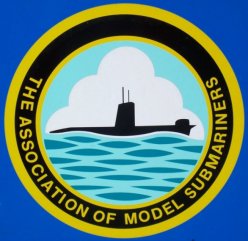We need to do some development work on these because aerials behave very differently underwater.
So far, I have just been using a very simple whip or rubber ducky aerial placed horizontally in the WTC.
Very neat to fit (no wire wrapped around things!) and it seems to work pretty well.
The wavelength at 458 Mhz is 0.66m so a quarter wave dipole area will be about 165mm long. And this is what I have used so far. (I am no aerial expert.)
But we have always known that you really need to substantially shorten the aerial length underwater, but we've never really bothered. (There is an article somewhere in the AMS magazine articles - I have not found it yet. Anyone know it?)
There is a very good article by Butler available online:
http://users.tpg.com.au/users/ldbutler/Underwater_Communication.pdf
This shows that the wavelength (and hence aerial length ) is affected by the frequency and the conductivity of the water.
I have used Butler's formula on page 3. I have halved the conductivity of Adelaide, Australia water for UK surface waters. (I assume less dissolved solids?, so I used a value of 0.03 mhos/m)
This gives a wavelength of 0.85m giving a quarter wave aerial length of 210mm. So that is what I will try next.
What is interesting is that it is not much different from the aerial length in air. I don't quite understand this yet!
My reading of his article also gives some further clues why 458Mhz works at all:
-The refraction/interface losses of the signal (i.e where your transmitter signal hits the water.) reduce at higher frequencies.
- A horizontal aerial is probably better than a vertical because of refraction at the surface.
Any aerial/antenna experts available to comment on this . (Where is Paul B when you need him!)
The final article is sort of interesting and perhaps shows that underwater radio communication has been rather overlooked.
http://www.hydro-international.com/issues/articles/id697-Underwater_Electromagnetic_Propagation.html
David
So far, I have just been using a very simple whip or rubber ducky aerial placed horizontally in the WTC.
Very neat to fit (no wire wrapped around things!) and it seems to work pretty well.
The wavelength at 458 Mhz is 0.66m so a quarter wave dipole area will be about 165mm long. And this is what I have used so far. (I am no aerial expert.)
But we have always known that you really need to substantially shorten the aerial length underwater, but we've never really bothered. (There is an article somewhere in the AMS magazine articles - I have not found it yet. Anyone know it?)
There is a very good article by Butler available online:
http://users.tpg.com.au/users/ldbutler/Underwater_Communication.pdf
This shows that the wavelength (and hence aerial length ) is affected by the frequency and the conductivity of the water.
I have used Butler's formula on page 3. I have halved the conductivity of Adelaide, Australia water for UK surface waters. (I assume less dissolved solids?, so I used a value of 0.03 mhos/m)
This gives a wavelength of 0.85m giving a quarter wave aerial length of 210mm. So that is what I will try next.
What is interesting is that it is not much different from the aerial length in air. I don't quite understand this yet!
My reading of his article also gives some further clues why 458Mhz works at all:
-The refraction/interface losses of the signal (i.e where your transmitter signal hits the water.) reduce at higher frequencies.
- A horizontal aerial is probably better than a vertical because of refraction at the surface.
Any aerial/antenna experts available to comment on this . (Where is Paul B when you need him!)
The final article is sort of interesting and perhaps shows that underwater radio communication has been rather overlooked.
http://www.hydro-international.com/issues/articles/id697-Underwater_Electromagnetic_Propagation.html
David
Last edited by david f on Sat Apr 04, 2015 11:34 am; edited 1 time in total






» RC Drift Gyro for pitch control
» WW2 mini sub build
» sonar data link
» Robbe Seawolf V2
» ExpressLRS - 868/915 Mhz equipment
» Flight controllers as sub levelers
» 868/915 Mhz as a viable frequency for submarines.
» Microgyro pitch controller corrosion